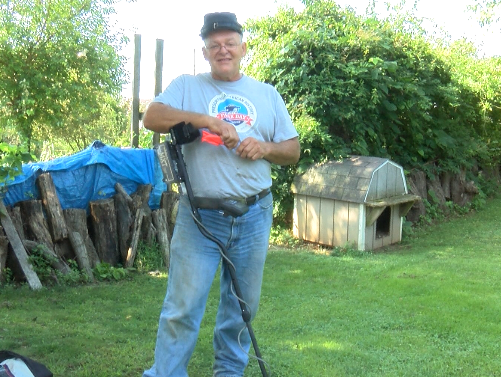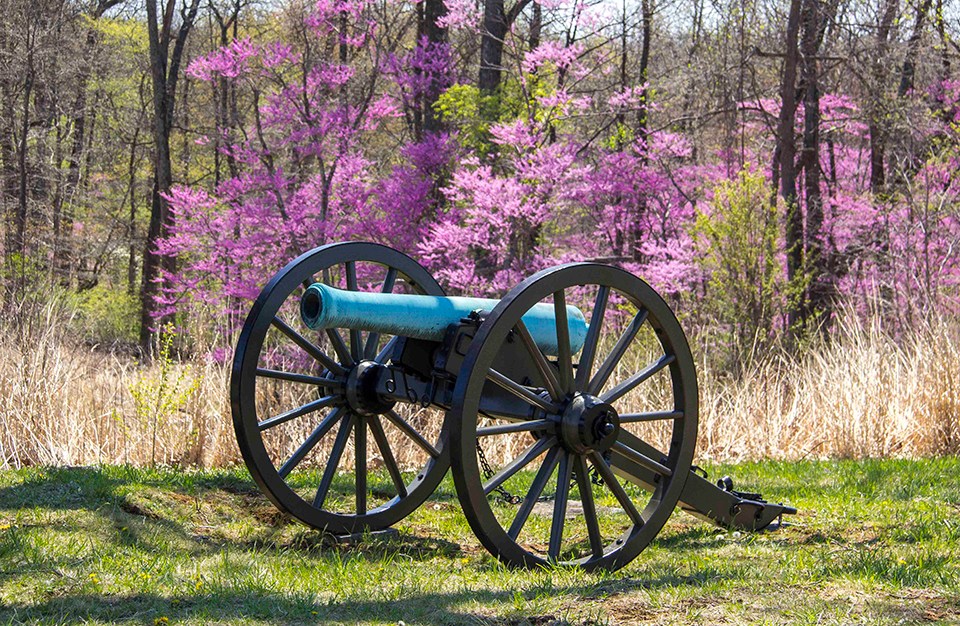Hedgesville group finds and displays Civil War relics
By Joseph LaFave
A Civil War re-enactor examines artifacts found by the Civil War Artifact Preservation Association.
HEDGESVILLE — One hundred fifty-four years have passed since the American Civil War came to an end, but one nonprofit group from Hedgesville is still working to uncover its artifacts.
Clarence "Paul" Martz, director of the Civil War Artifact Preservation Association, said that he is still working alongside his partner John Barone to search battlefields for glimpses into the past.
"We preserve civil war artifacts, document them, and showcase them," Martz said.
Working with permission from private landowners, Martz and Barone comb the hallowed ground using a metal detector.
Every time they get a "beep," they place a small surveying flag on the spot. Eventually, said Martz, the battle starts to take shape through the location of the flags.
"The flags tell the story, once, at the Battle of South Mountain, I could tell where the union line was because of the flags."
Once the flags have been placed, Martz said he begins to dig them up one by one.
Using a square shovel, Martz removes the piece of earth, locates the artifact, and replaces the dirt; that way, no hole is left once the excavation is finished.
Clarence “Paul” Martz, left, and John Barone pose in front of a Civil War Artifact Preservation Association banner. Martz and Barone began the nonprofit organization in 1997.
Submitted photo
"I have lots of respect for the owners [of the land]," said Martz.
"We always get permission and never leave holes."
The Civil War Artifact Preservation Association was started in 1997, but Martz has been interested in the Civil War for much longer.
He has been a Civil War re-enactor for the last 30 plus years, an experience that gave him the idea to begin looking for Civil War artifacts.
"I always saw people with reproductions, but I said 'I bet people want to see the real stuff,'" said Martz.
His time spent as a re-enactor, living as Civil War soldiers lived, helps him determine where to look for artifacts, he said.
"You have to picture yourself as a re-enactor, if you were a soldier, where would you go, what would you do?"
Since starting the nonprofit, Martz said he has found a multitude of artifacts.
He has unearthed everything from artillery shells and bullets to belt buckles and personal items.
Still, one object in particular sticks out in his mind as being the most valuable.
"The most valued thing that I actually found was a Georgia state belt buckle that I found on the retreat route at the Battle of Antietam," said Martz.
Although it is illegal to hunt for artifacts on preserved battlefields, Martz said some of the battles took place on ground that today is privately owned.
As long as the owner gives permission, Martz said he is free to search for pieces of history.
Image courtesy of the Civil War Artifact
Preservation Association
Submitted Photo
Once the artifacts have been found, Martz said the organization would catalog them and place the finds in display cases.
The Civil War Artifact Preservation Association donates some of these cases to museums, while others are loaned out to schools so people can get a look at real Civil War relics.
The most valuable items are donated to museums.
Martz said he also takes donations of artifacts that other people find and uses any money donated tot he nonprofit to buy more display cases.
Local civil war reenactor dedicates his life to finding artifacts
by: Stephanie Duprey
Posted: Jul 27, 2019
SHARPSBURG, M.d. (WDVM)
Since 1997, a West Virginia man has dedicated his life to digging the ground near and around Antietam National Battle Field for Civil War artifacts.
While being a civil war reenactor for over 30 years, Clarence Martz has been glued to his metal detector for more than 20 years.
He has collected many great artifacts, all with different meanings.
“At the reenactments I would see people bring reproduction stuff to encampment and living history and I thought to myself, why not the original stuff,” Martz said.
Since there is no digging allowed on the state land or battle field, he investigates the surrounding areas.
Saturday afternoon he spent the day at the John Shay house in Sharpsburg.
It was built in 1825 and served as a field hospital for wounded confederate and union soldiers.
The home owner who asked not to be identified says one of the most touching artifacts is a bullet that was cut by a surgeons saw.
“What it says, at that point, it didn’t matter if it’s union or confederate, this was a young American probably eighteen or nineteen years old that had a limb cut off, it brings tears to my eyes at times because its a small thing but a very important thing because that’s the reality and that happened here at this house.”
While out in the field Martz says when the metal detector goes off the flags he puts in the ground play a significant role.
“Number one, to point where the artifact is, number two is after its said and done at the end of that day we can stand back and actually see the movement of the union and confederate of both armies by the movement of the flags,” Martz also said.
The homeowner says along with the physical history, there is also some positive paranormal activity that helps guard the grounds.
The homeowner says he feels privileged to live in a home with so much history and is honored to be able to work with Clarence for as long as they can.
______________________________________________________________________
The Battlefield OF Gettysburg
On
Facebook






